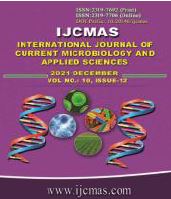


 National Academy of Agricultural Sciences (NAAS)
National Academy of Agricultural Sciences (NAAS)

|
PRINT ISSN : 2319-7692
Online ISSN : 2319-7706 Issues : 12 per year Publisher : Excellent Publishers Email : editorijcmas@gmail.com / submit@ijcmas.com Editor-in-chief: Dr.M.Prakash Index Copernicus ICV 2018: 95.39 NAAS RATING 2020: 5.38 |
The study mainly aims to analyze the value chains for the production, processing and marketing of the garlic crop in Beni Suef Governorate, Egypt and the most important problems and obstacles it faces in the production, manufacturing and marketing stages, and to propose solutions to them. The results show that the best pictures for marketing garlic can be arranged as follows. Exporting fasting comes in the form of mature, plasticized garlic, followed by exporting it in the form of dried garlic slices or powder, then in the form of immature garlic, and finally in the form of mature garlic, where the added value of each of them is about 28,648 pounds. 28,350 pounds, 24000 pounds, zero pounds, respectively. In the case of arranging according to the net return indicators, the total return on costs and the return on the invested pound, the export of plasticized ripe garlic comes in the first order, followed by immature garlic, then dried and then mature garlic that is marketed in the local market, where the value of the net return amounted to about 25468, 19885, 16615 and 10688 pounds, respectively. While the return on the invested pound amounted to about 2.09, 0.99, 0.53, and 0.49 for each of them, respectively. Beni Suef Governorate is considered the first in terms of area and production of garlic for the republic, where it is planted about 36.4%, and produces about 40.4% of the production of the republic and the average costs of production per fed amount to about 21.712 pounds, the percentage of fixed costs in it about 30.2%, while variable costs represent about 69.8%. Rent comes in the first order of fixed costs, representing about 29.5% of the total costs, while labor costs in all stages of production come at the forefront of the arrangement of variable costs and represent about 19.7%, followed by the costs of chemical fertilizers, which represent about 13.9% of the total costs.
 |
 |
 |
 |
 |